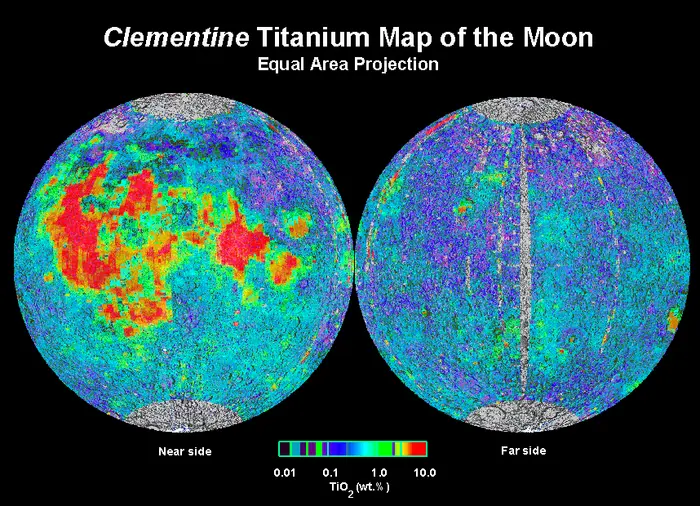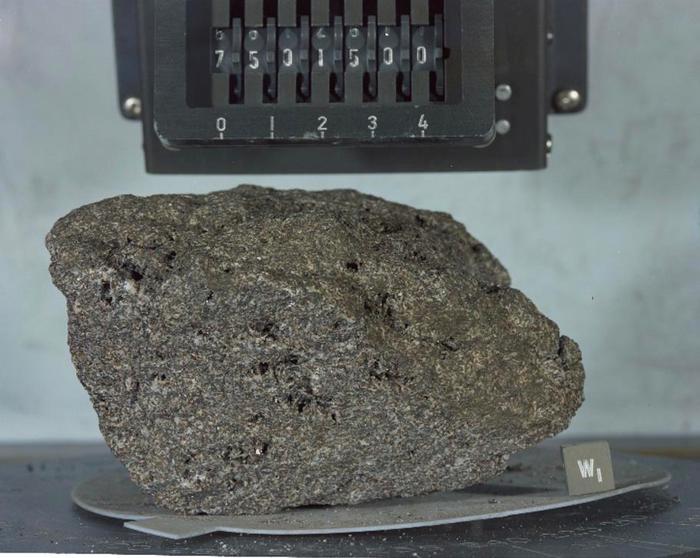Many lunar deposits are curiously high in titanium, with TiO2 accounting for up to 18 percent of some samples by weight. As interesting as that may be to future miners, this fact has also intrigued planetary scientists, who for more than 50 years have been unable to explain how these rocks could form – let alone reach the lunar surface. Now the puzzle has apparently been solved.
When the Apollo astronauts returned from the Moon with 380 kilograms (840 pounds) of rocks, some of their samples were familiar to geologists. Others were not, but only because they required unearthly conditions, such as an absence of water or air, to be produced. However, some lunar substances defied obvious explanations. The volcanic basalts that make up the lunar “seas”, for example, turned out to be much more diverse in composition than their Earthly equivalents, with a hundred-fold difference in titanium concentrations standing out.
High-titanium basalt has remained a mystery ever since. Mapping from orbit that revealed these rocks were quite widespread deepened the puzzle.

The Clementine mission to the Moon revealed how widespread the high-titanium basalts, at least on the near side.
Image Credit: Lunar and Planetary Institute
Now, a team co-led by Professor Tim Elliott of the University of Bristol has come close to recreating the mystery basalt in the lab, in the process providing an account of how they could have formed on the Moon.
“The origin of volcanic lunar rocks is a fascinating tale involving an ‘avalanche’ of an unstable, planetary-scale crystal pile created by the cooling of a primordial magma ocean,” Elliott said in a statement. “Central to constraining this epic history is the presence of a magma type unique to the Moon, but explaining how such magmas could even have got to the surface, to be sampled by Space missions, has been a troublesome problem. It is great to have resolved this dilemma.”
The problem wasn’t just that the basalt is high in titanium, but its low density compared to the most similar rocks on Earth. This lightness contributed to widespread eruptions 3.5 billion years ago, before the Moon ceased to be volcanically active – but geologists had trouble explaining how this composition arose, and why only on the Moon.
Some geologists suggested the titanium-rich basalts came from materials in the lunar mantle known as ilmenite-bearing cumulates. However, partially melted cumulates in the lab don’t match the basalts in question. Moreover, the product is so dense it’s considered improbable it could have reached the surface.
Elliott and colleagues have now shown that when ilmenite-bearing cumulates react with the common mineral olivine and orthopyroxene, the melted product matches the titanium-rich basalts people have been struggling to explain. The match extends to its low density, making the widespread eruptions make sense.

A high titanium basalt from Apollo 17 used for the study.
Image Credit: NASA
“Although this model does not fully replicate lunar melt–solid interaction, we suggest that titanium-rich magmas erupted on the surface of the Moon can be derived through partial melting of ilmenite-bearing cumulates, but melts undergo extensive modification of their elemental and isotopic composition through reactive flow in the lunar mantle,” Elliott and co-authors write. “Reactive flow may therefore be the critical process that decreases melt density and allows high-Ti melts to erupt on the lunar surface.”
The work is published in the journal Nature Geoscience
Source Link: The Origin Of The Most Mysterious Moon Rocks Has Been Explained